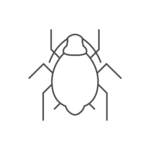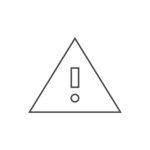Plant Health Information
The production of healthy plants is the prerequisite for the production of high quality food. By protecting Austrian plant production from the introduction and spread of dangerous quarantine pests (QS: insects, mites, viruses, bacteria, fungi and invasive plants), the conditions for ensuring healthy plants are created. For more information, visit the Official Plant Protection Service and National Reference Laboratories.
You can also find a wide range of information for harmful organisms on plants that already occur in Austria under Harmful organisms from A to Z and specific services under Information on plant health and Plant health warning service.
Quarantine pests
Quarantine pests (QS) are organisms with potential harmful effects on plants in endangered areas where the quarantine pests have not yet appeared or are not widely distributed there. They can be organisms of any species, strain, or biotype of plants, animals, or pathogens (bacteria, fungi, or viruses) that cause major economic damage to plants. They pose a high risk to our agriculture and forestry industries through their introduction via trade and transport and subsequent spread.
Since December 14, 2019, there has been a reclassification of quarantine pests. More detailed information can be found here.
The occurrence of quarantine pests must be reported to the official plant protection service of the relevant federal state. The legal basis for this is the Plant Protection Act 2018 as amended., the Planting Material Act 1997 as amended and, if applicable, the Seed Act 1997 as amended.
The specialist group of the Official Plant Protection Service coordinates phytosanitary matters in the area of quarantine pests.
Invasive plants
The discovery of the New World in 1492 marked a turning point. Foreign plant species (neophytes) were now able to overcome their biogeographical boundaries with the help of humans and reach Europe (and vice versa). Deliberate import was and still is the most important route of introduction and is mostly economically motivated: new species are to be brought in for cultivation in agriculture and forestry, for gardens, parks or aquariums. Today, in addition to intentionally introduced species, rapidly growing global trade and transport are the main contributors to the unintentional introduction of alien species. "Invasive" is the term used to describe those alien plants that can cause damage to their environment.
In our pest database you can search specifically for invasive plants.
Ecological, economic and health impacts
The vast majority of alien plants integrate into existing plant communities without any problems. However, invasive plants can cause damage and, for example, displace native species and permanently alter the structure and function of ecosystems. These plants are now among the second greatest threats to biodiversity worldwide. In addition, alien plants can cause economic costs or affect human health.
The situation in Austria
In Austria, there are currently about 1,100 alien plants, of which one fifth of the species have been able to establish themselves permanently in the wild. From a nature conservation perspective, 17 plant species are currently classified as invasive. These include, for example, the god tree(Ailanthus altissima) and the black locust(Robinia pseudoacacia). An additional 18 species are considered potentially invasive. These species are likely to cause ecological problems if they continue to spread. Invasive alien plants particularly invade habitats such as riparian forests, tall herbaceous vegetation and dry sites in the Pannonian region.
New invasive weed species in agriculture.
Numerous species also cause problems for agriculture. Some have been an integral part of the weed flora for decades, while others have only recently become established. Long-established, for example, is the recurved foxtail(Amaranthus retroflexus). The plant is native to the central and eastern United States and northeastern Mexico. It is believed that Linné introduced this species around 1750 to cultivate it in the botanical garden of Uppsala. In Western Europe, the species first appeared subspontaneously in Paris in 1783 and spread rapidly across much of Europe to Austria from about 1800.
On the other hand, the appearance of new, often heat-loving weed species in agriculture has been increasingly observed in recent years. These include, for example, tiger grass(Cyperus esculentus), eleusine(Eleusine indica), velvet poplar(Abutilon theophrasti) and poison berry(Nicandra physalodes).
Globalization and climate change
It is certain that new (invasive) species will continuously appear in Austria as well. The reasons are manifold: introduction via contaminated seeds, commercial goods and vehicles, or feral ornamental plants. The expected warming of the climate also plays a role that should not be underestimated. It favors the appearance of new weed species of meridional-subtropical origin in Austria. However, many already established warmth-loving species that have so far only occurred in certain regions of Austria will also benefit.
One example is the ragweed(Ambrosia artemisiifolia). Currently, its main distribution is restricted to the warm lowlands of eastern Austria. However, as a consequence of climate change, a rapid spread of the species to other parts of Austria is to be expected.
Plant Health Services
Without plant protection, the production of healthy plants in sufficient quality and quantity is not possible in agriculture. A large number of pests and pathogens threaten main crops such as cereals, corn, sugar and fodder beets, rapeseed, sunflower, potatoes, soybeans and oil pumpkin.
But even smaller crops in terms of area, such as poppies, sweet lupins, hemp or safflower, can be damaged in quality and quantity by a wide variety of harmful organisms. Weeds and grasses, but also invasive plant species can reduce yields or lead to undesirable residues in the crop.
We are at your disposal as a competent partner for a wide range of questions and tasks concerning the health maintenance of plants.
We offer you a wide range of tests for diseases and pathogens in plants, plant parts, planting material and soil. In our accredited laboratories the most modern methods are available for the examinations and diagnoses. Our services are aimed at farmers (field crops, horticulture, fruit growing, viticulture, vegetable growing, also under glass) as well as home and allotment gardeners.
In our pest database you will also find detailed information on the individual pests.
The Plant Health Warning Service publishes warnings about the current spread of various pests.
Sample collection and prices
Samples can be sent by mail or parcel services, but can also be delivered in person during the following hours:
Monday to Thursday from 07.30 to 16.00 Friday from 07.30 to 15.00
If you need personal advice or further information, our technical staff is available daily from 08.00 to 14.00 by appointment.
The current price list for plant health tests can be found at the end of this page under Downloads.
Nematode survey
Plant-parasitic nematodes are important pests of agricultural crops (field crops, field and protected vegetable crops, vines, and fruit crops). They are typical fruit-follower pests and can build up considerable damaging nematode densities for the following crop by growing host plants. In the crop, irregularly growing plants or a nest-like stunted growth indicate infestation with plant-parasitic nematodes. These can severely impair plant growth and result in significant quality and yield losses in the affected crop.
A soil test will indicate nematode distribution at the time of sampling. Sampling in the field can be carried out from March onwards. For crop planning in the following year, sampling should be carried out in autumn, as the number of nematodes is highest here and there is sufficient time for crop rotation planning and control options.
Cyst-forming nematodes
Cyst nematodes are of great economic importance in potato, beet and cereal production and in field vegetables. Infestation with cyst nematodes can cause considerable yield losses. Under unfavorable conditions, such as high initial stocking, early infestation and poor water supply, these can amount to up to 50 percent in a susceptible variety.
Cyst-forming nematodes are detected by extracting them from soil samples using the soil sample extractor.
Soil sampling
For soil testing for beet cyst nematodes, at least 200 punctures per ha should be made using a drill stick from a depth of 0 to 30 cm. From this, prepare a composite sample of one liter of soil.
Then fill the sample into a freezer bag and label it. In addition, please enclose the completed application form for clients of the Institute for Sustainable Plant Production.
The samples should be protected from drying out and stored in a cool place (below 8° C) until transport. Transport should take place as soon as possible.
Performance and prices
The soil samples are tested in the laboratory using the MEKU soil sample extractor. The MEKU is a program-controlled laboratory device for use in nematology, which works on the principle of the Seinhorst can and is able to process both dry and wet samples. The diagnosis includes the evaluation of the cysts present in the samples, the species identification and the viability of the cysts. The result will be communicated to you with the examination report.
Free-living nematodes
In order to detect an infestation with free-living nematodes at an early stage, regular monitoring is necessary. If a nematode infestation is suspected, it is recommended to carefully dig up some plants from the suspicious areas in the field (e.g. reduced growth, yellowing).
Symptoms at the root often provide a good indication of the cause. If necessary, plants and/or soil samples should be taken and examined for possible nematode infestation.
Soil sampling
Prior to seeding or planting:
Again, sampling is done with a boring stick at a depth of 0-30 cm and at least 30 punctures should be made for each area to be tested. The amount of composite sample sent for testing should be 1 kg. Please put the sample in a freezer bag and label it. The samples should be stored in a cool place until shipment. In addition, please enclose the completed application form for clients of the Institute for Sustainable Plant Production.
During the growing season (in case of visible damage):
Take one soil sample each from the infested area (visible damage) and the healthy area of the plot. The composite sample sent for testing should be 1 kg.
Service and prices
Soil and plant samples are tested in the laboratory using the Oostenbrink elutriator and the Baermanntrichter method.
The Oostenbrink elutriator uses a manually controlled procedure to extract free-living nematodes from soil samples and is specifically designed for nematological testing. Wet samples are processed.
The diagnosis includes the evaluation of the free-living nematodes in the samples, the species determination as well as a quantitative evaluation related to a defined soil volume. We will inform you about the result in the examination report.
The prices for laboratory tests can be found in the download at the bottom of this page.
Contact
Institut für Nachhaltige Pflanzenproduktion
- pflanzengesundheit@ages.at
- +43 5 0555-34200
-
Spargelfeldstraße 191
1220 Wien
Last updated: 18.01.2024
automatically translated


